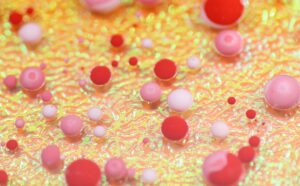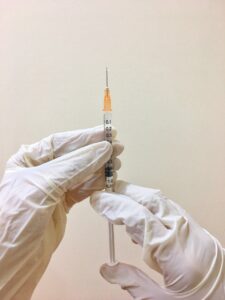Pucker up! Today we’re talking mistletoe as an alternative or complementary treatment; and yes, I do mean the same mistletoe that people kiss under at Christmastime, although we’re using it in a completely different way here 😛Read on to discover the anti-cancer benefits of this plant that offers more than we give it credit for. The next time someone tries to sneak a smooch underneath it, you can tell them all about its role in the fight against cancer! 🌿
 Not Just for Smooching
Not Just for Smooching
There are three types of mistletoe (European, Koren, and American), but when it comes to cancer we are concerning ourselves with the European variety. European mistletoe is a semi-parasitic plant that has been in the healthcare game for a long time. It has been used historically to treat everything from headaches to infertility, and according to a 2009 literature review of studies done with mistletoe and cancer patients, that despite some obvious limitations, “[…] one can not ignore the fact that studies with positive effects of VA-E [mistletoe extract] on survival of cancer patients are accumulating”1. Mistletoe is commonly used in European countries and is approved for cancer care in Germany, however in North America, it has been relegated to the alternative world of medicine. Hopefully, with continuing research, it will become just as common here one day.
Although there have been mixed results with trials and more research is definitely needed to determine why the results vary so much (reasons could be dosing, other therapies or drugs it is combined with, stage or grade of cancer, type of cancer, etc.), there have been both human and animal trials that have confirmed the positive effects of mistletoe on survival and quality of life. A range of positive side effects have been reported by trial participants such as fewer adverse events when also treated with chemo or rads and better symptom relief (improved pain, weight loss, fatigue, nausea, diarrhea, and anxiety), and studies have found that mistletoe can improve disease-free survival, stimulate the immune system, reduce tumours, and slow disease progression 2, 3. That’s one powerful plant!
 How Does it Work?
How Does it Work?
The mechanism by which mistletoe is believed to slow disease and improve survival outcomes is through its cytotoxic effects (toxic to living cells) and immunological effects (ability to elicit an immune response).
Mistletoe contains a number of proteins called lectins. These proteins have been shown to positively affect the immune system by increasing macrophage cytotoxic activity (the ability of your white blood cells to have toxic effects on cancer cells), stimulating phagocytosis by immune cells (their ability to ingest and therefore dispose of pathogens), and increasing cytokine secretion (substances excreted by immune cells that have a variety of effects). Furthermore, preclinical studies suggest that mistletoe increases the number of white blood cells and improves their ability to interact with and recognize cancer cells, leading to increased cytotoxic effects. Mistletoe has even been found to trigger apoptosis (programmed cell death) and necrosis of tumours3!
 How is it Delivered?
How is it Delivered?
If you decide to include mistletoe in your protocol, there are two main ways that it is delivered: intravenously and subcutaneously. Your naturopath or integrative doctor may decide to use one or both of these methods. With intravenous delivery, the mistletoe extract is often injected into a high-dose vitamin C IV bag and administered concurrently with this other popular therapy. With subcutaneous injection, a small needle is used to inject the extract just below the surface of the skin, into the fat layer that resides there. Intravenous administration is often used initially in conjunction with subcutaneous, and then subcutaneous is continued on its own for maintenance.
 Are There any Reported Side Effects?
Are There any Reported Side Effects?
There have been a very small amount of anaphylactic reactions reported in those who were allergic to mistletoe and didn’t know it, but that is it for serious side effects. The others are pretty mild and include a slight fever and redness, itchiness, and swelling at the injection site when administered subcutaneously4. We are actually looking for these mild reactions however, because they are the evidence that the mistletoe is doing its job and stimulating your immune system. If you stop reacting in this way, it is likely that your body has grown used to the current dose you are taking and it may be time to take a break or increase the strength or amount of the injection.
My Experience with Mistletoe
For the first 6-8 months of my treatment, I received mistletoe twice a week. When I went for my vitamin C IVs twice a week, I would get one dose of mistletoe in my IV bag and one dose subcutaneously. I then went down to getting only a subcutaneous injection once a week when we decreased my vitamin C IVs to the same. Now, since I only receive an IV once a month as a maintenance dose, my naturopath gives me enough supplies for a month’s worth of injections and I do them myself at home. Because your body gets used to mistletoe and you eventually stop having a reaction, I do them once a week for four weeks and then take a complete break for two weeks in order to allow my body’s resistance to dissipate.
The injection itself feels a bit like getting a bunch of little bee stings; you definitely feel it happening, but it’s completely tolerable, and I have no problem doing it myself. And once it’s done (10 seconds or so), the discomfort significantly drops off. If that’s not something you feel comfortable with, no worries! There is no issue with having your ND or MD do them for you, it’s just more convenient for me to do them myself now that I’m not at her office all the time. The most common side effects I experience are exactly those described above: I sometimes feel a little shivery and fevery (although not always), and my skin gets red and itchy at the injection site. Remember, this reaction is a good thing! It means that your immune system is being stimulated into responding; when you stop getting this type of reaction is when you have to change up what you are doing by either upping the dose and strength or giving your body a break.
The combination of IVC and mistletoe was fantastic for me. It gave me a lot of confidence that I was doing everything I possibly could to attack this thing, particularly because I only did partial chemo and refused radiation. Going forward, the injections give me significant peace of mind by helping me feel as though I am doing all I can to prevent a recurrence and keep my immune system strong. As an anecdotal side note, I went from getting really sick about 6 times the winter before my diagnosis, to getting the sniffles once or twice a season with it never turning into a full blown cold. I am a teacher after all, and germs are unavoidable in that line of work!
I highly recommend discussing the possibility of adding mistletoe to your protocol with your ND or integrative MD, and if you have any questions at all regarding my experience with it, please feel free to leave a comment below. And while you’re there, consider signing up for my mailing list to stay up to date on everything new at Solis. You will receive my anti-cancer diet guide free when you do!
To your happy healing ❤️
References
- “Survival of cancer patients treated with mistletoe extract (Iscador): a systematic literature review”: https://bmccancer.biomedcentral.com/articles/10.1186/1471-2407-9-451
- “Mistletoe Extracts (PDQ®)–Patient Version”: https://www.cancer.gov/about-cancer/treatment/cam/patient/mistletoe-pdq
- Ottawa Integrative Cancer Centre, “Professional Resource: Mistletoe”: http://www.oicc.ca/uploads/mistletoe-health-professional.pdf
- “Safety of Intravenous Application of Mistletoe (Viscum album L.) Preparations in Oncology: An Observational Study”: https://www.ncbi.nlm.nih.gov/pmc/articles/PMC4052504/




what injections do you use? name and company thsnk you
Hi Alina,
I get my mistletoe from my naturopath. The clinic uses Helixor, and they have determined that 100M is the strength that is right for me. With mistletoe, it’s important that you get input from a healthcare professional who has experience with mistletoe to help guide you on dosing and strength. You could also get in touch with Helixor and they may be able to provide you with some guidance.
I split the 100M into multiple doses, as you want to take the minimum amount needed to get a reaction after injection (redness, slight swelling, mild itchiness, etc.). I do 75M one week, 50M the next, 75M the third week, 50 M the fourth, and then I take two weeks off; this is to help prevent my body from becoming as accustomed to the mistletoe and to keep me reacting to a lower amount for longer. When you stop getting a reaction with your current injection amount, you increase either the amount you inject or the strength of the mistletoe.
Hope that helps!